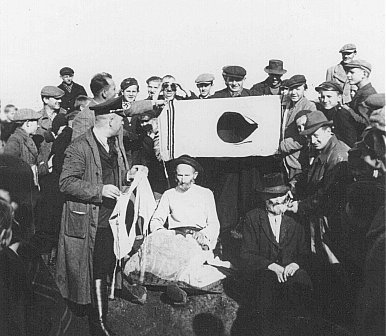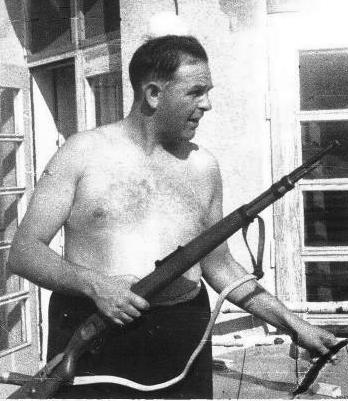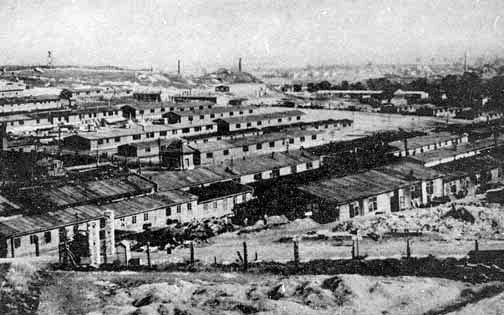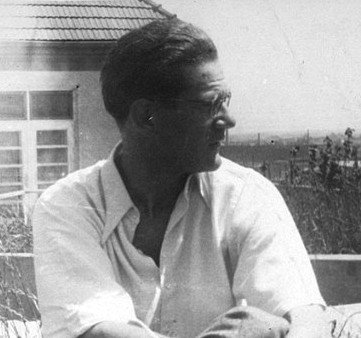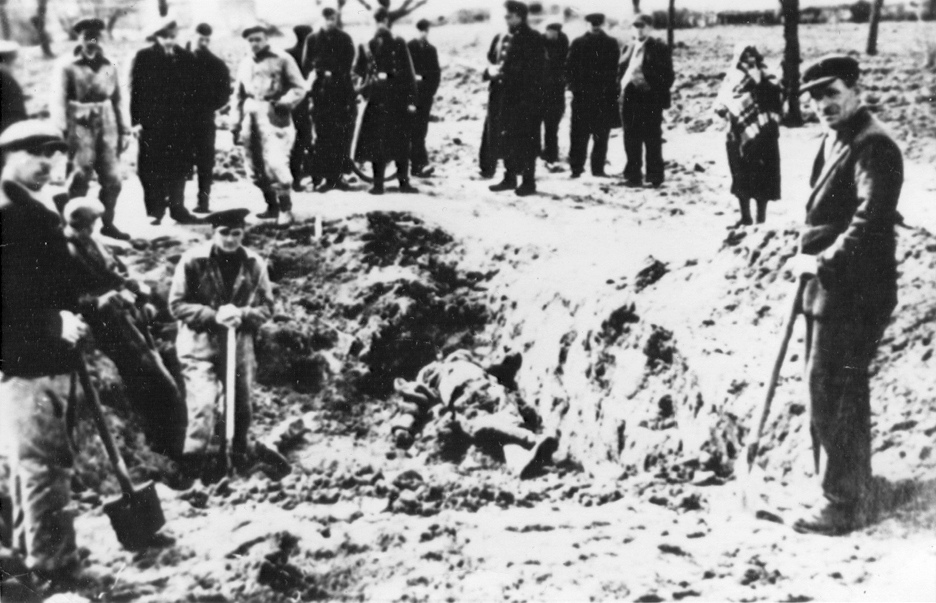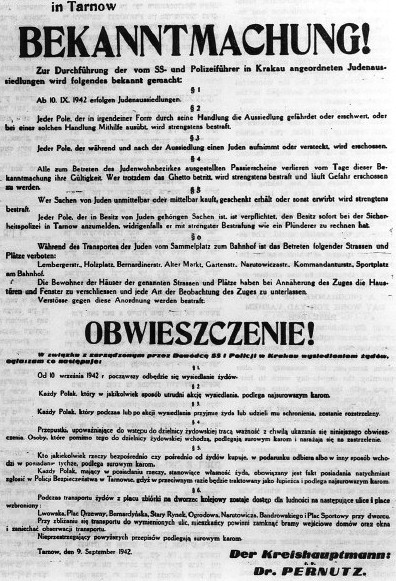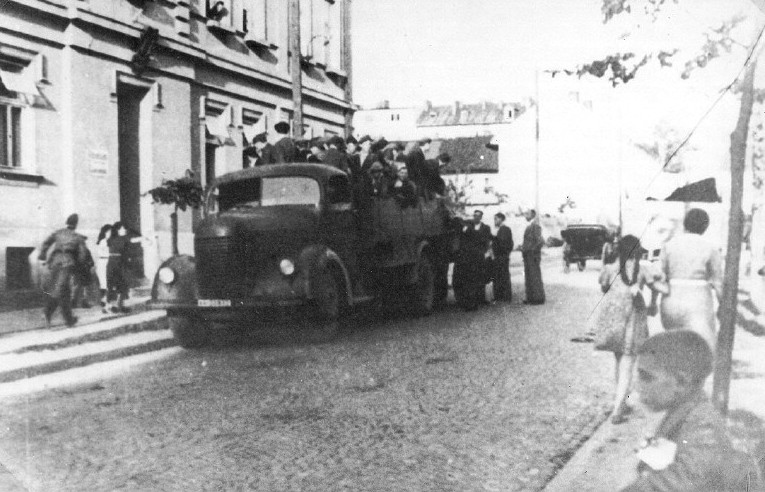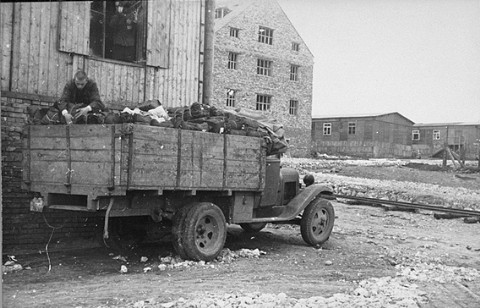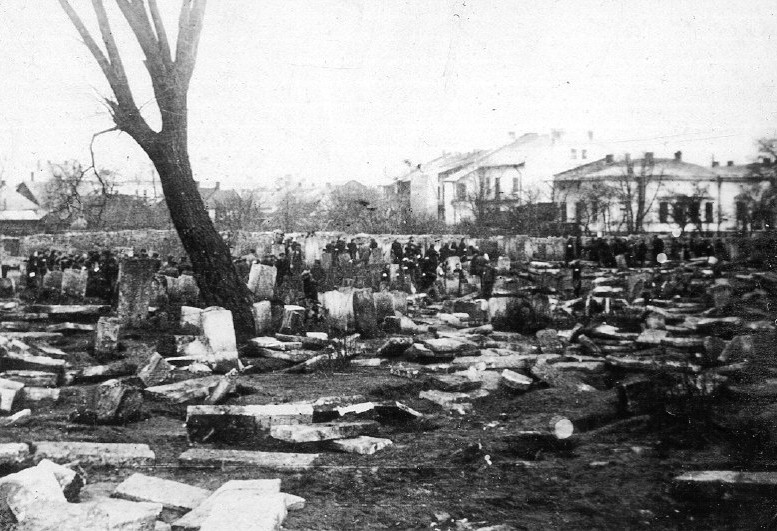Holocaust Education & Archive Research Team |
|
Occupation German Occupation of Europe Timeline
-
[The Occupied Nations]
Poland Austria Belgium Bulgaria Denmark France Germany Greece Hungary Italy Luxembourg The Netherlands Norway Romania Slovakia Soviet Union Sudetenland | |||||
Tarnow Ghetto – Amon Göth & the Final Deportation
September 1943
During the summer of 1943, there were still about 9,000 Jews in the Tarnow Ghetto, the Ghetto was divided into two sections “A” and “B.” Section “A” accommodated Jewish men, women and children aged 12 years and above, all of whom were organised into working squads who paraded daily in columns to march to their work sites inside and outside the ghetto.
This section of the Ghetto had the official name: “Forced Labour Camp T.” Section “B” accommodated Jews of both sexes and of all ages who were unfit for work, including children below the age of 12 years.
Both sections were separated by a wooden partition. Inmates of one section were not permitted to enter the other section. The Ghetto measured 1km long and 200m wide and was surrounded by a wooden fence of 2m high. Contact between the male area and the female area within the Ghetto Section “A” was also strictly prohibited. Jews violating this directive were shot by the Gestapo.
During the middle of August 1943, a conference was held in the office of SS-Obergruppenfuhrer Friedrich Kruger in Krakow with SS-Oberfuhrer Scherner presiding. Also in attendance Chief of the Tarnow Gestapo Palten and SS chiefs Bernhard and Blache, they learned that a fourth aktion would take place in early September 1943, and that it was designed to deport the remaining Jews.
A sinister appointment was made by Schener in the appointment of Amon Leopold Göth the commander of the Krakau-Plaszow Forced Labour camp. Göth served with Globocnik as a member of Aktion Reinhard, and liquidated the Krakow Ghetto and a number of other ghettos in Poland.
At the end of August 1943, a further conference was held to fine-tune the fourth and final action in Tarnow. The details of the intended operation were established.
According to the details 200 Jewish males and 100 Jewish females were to remain in the ghetto to serve as a clear-up party. 2,000 Jews from the Madritsch clothing factory were to be transferred to Krakau – Plaszow Forced Labour Camp.
When the Krakow Ghetto was liquidated on the 13 March 1943 Julius Madritsch transferred 232 men, women and children from Krakow to Tarnow. This took place on the 25 and 26 March 1943.
On the 3 September 1943 the Ghetto in Tarnow came to a brutal and violent end. The day before the liquidation Madritsch and Raimund Titsch were invited to a ceremonial dinner for Commandant Göth and other high SS officials. When Madritsch requested to leave the dinner, Scherner ordered him to stay until dawn and left him with two SS officers to keep them company.
At 5am the following Madritsch and Titsch were released, they drove directly to Tarnow where they saw Göth. Göth informed them that the Tarnow Ghetto had been liquidated but assured Madritsch that his workers were safe for the time being.
Large bribes were not offered, but demanded by Göth and Scherner. Madritsch had observed that there had been a fierce resistance in the Ghetto and many Jews had been shot. All the Jews who survived the onslaught in Tarnow Ghetto were transported to Auschwitz – Birkenau. Only the Jewish workers at the Madritsch works survived.
The remaining Jews, approximately 6,000 were to receive “special treatment” in Auschwitz-Birkenau. In order to avoid any suspicion and panic amongst the Ghetto Jews it was arranged that the Jews were to parade in the usual working squad columns on the morning of the evacuation day.
On the 2nd September 1943, instructions were given that the action would commence the following day. On the morning of the 3rd September 1943, the SS/SD and the Auxiliaries mentioned in other actions, surrounded the Ghetto.
The working Jews from Ghetto Section “A” paraded just as on any other day. The Jews from Ghetto “B” also gathered in Magdeburger Platz. The Jewish population was lead to believe by way of announcements that the Ghetto was being cleared and its inmates transferred to Krakau-Plaszow Forced Labour camp. The actual objective of the action, namely the intended extermination of the majority of the Jews, was concealed on purpose.
The Jewish clearing kommando was now organised and was primarily made up from Jewish men and women who had, until now, been working in the operations and workshops located inside the Ghetto.
They were made to parade in the factory grounds of the Singer crate factory which proved to be extremely suitable for the purpose because of the already existing fence. A sentry was posted at the entrance to the factory grounds to prevent Jews selected for the deportation to defect into the rear cleaning party.
.There is no doubt that Göth with his previous experience in Ghetto clearing was aware of all the attempts the Jews would employ to escape detection. The Jewish man Leon Leser, 39 years old was selected for the cleaning squad:
“Very early on the morning the whole Ghetto was surrounded, that was 3am in the morning. I walked into Magdeburger Square. As the people were assembling they knew something was brewing.
At 7am Göth arrived in the Ghetto and was approached by the people who asked what was about to happen. Göth told them that they were being transferred to Plaszow Camp, and that we were to take out valuables and clothes.
Göth roamed over the Ghetto and ordered all Jews to assemble at their work places. There were groups working for the “Ostbahn” and “Madritsch.” At the assembly Göth selected 300 workers, 200 men and 100 women. I was among them. A woman by the name of Batista begged Göth to allow her to stay. Göth turned around and shot her dead.
Later that morning Göth returned in his car, followed by a covered lorry which parked just off the square. One man, one woman and two children emerged from the covered lorry. He ordered them into the street and killed them with one shot.
Another four emerged from the lorry and were also shot, and it continued, 40 or 50 people all shot by Göth. He was so tired with the shooting that he wiped the perspiration off his forehead and ordered a bowl of water to wash his hands.”
What followed next was the selection of Jews for employment at Krakau- Plaszow Zwangsarbeitslager and of those intended for deportation to Auschwitz – Birkenau. This selection was, however, only carried out with the inmates of Ghetto “A” as the Jews of Ghetto “B” had already been selected for extermination from the beginning.
Judging from the way the selection was carried out, the Jews had no doubt with their experience gathered on the occasion of the 1942 Evacuation Schemes in mind, that this was the end of the Ghetto.
Many of the Jews also realised that the Jews separated and gathered in the Singer factory grounds were intended for a special assignment and not for immediate extermination. Many Jews recognising the idea behind the separation therefore tried to escape their fate by switching over to the group of those presently selected to stay alive.
Göth and the other Gestapo officials had anticipated this and treated the Jews who attempted to join this group with unbelievable brutality. Carrying his pistol in his hand, Göth walked through the rows of Jews shouting at them and dealing out blows.
Those Jews who didn’t act quickly enough or changed rows were shot dead immediately. Göth attacked a Jewish woman called Zimmermann and dealt her such a blow that she fell to the ground dead.
Again there was mayhem, Jews shot out of hand, bodies strewn across the square, blood everywhere. In order to clear the Ghetto as quickly as possible, the Gestapo and Jewish Auxiliary Police carried out searches in the houses for Jews who were in hiding. Those found were shot on the spot.
On that same afternoon, Jews were lead in groups from Magdeburger Platz to the railway station and loaded into goods wagons, 160 Jews per wagon, which were then sealed. The venting holes of the wagons were closed with wooden planks nailed over them.
The “aktion” continued until the following morning, although the majority of Jewish children too small for work had been deported from Tarnow during the second evacuation in September 1942 a number of Jewish parents and relatives had managed to hide children in Ghetto “A.”
Jews attempted to smuggle these children out of the Ghetto and to take them with them into an unknown future. These attempts to take the children with them, were aided by the fact that during the fourth evacuation scheme they were allowed to take part of their belongings with them.
They were therefore carrying bundles, bags and rucksacks, in which they had hidden their smaller children, when parading in the square. Despite baggage searches there were still a number of Jewish women who had managed to take children hidden in pieces of luggage and rucksacks with them on the transport.
When the crying of the children was heard coming from the inside of the wagons, a search was conducted by the SS and a number of children were discovered. The women looking after these children were taken back along with the children – there were said to have been at least 50 women and children – in a truck to the Ghetto.
When the truck arrived back at Tarnow Ghetto, Göth and the other SS started to shoot at the women and children. The women and the children fell down behind the truck wounded or shot dead. There were no survivors.
Berek Figa, a tailor in the Tarnow Ghetto, age 52 years of old, witnessed the murder of these Jews:
“”On the 1st September 1943, I was present during the liquidation of the Tarnow Ghetto. On the Thursday morning we were all standing on the Magdeburger Platz. I saw one woman attempting to cross the square. Göth ordered his driver to “put her down,” the driver duly obeyed, and shot her.
On the next day, the Friday, we were the last group in the Ghetto, and I saw Göth shooting at least 50 men, women and children. The children were being shot because their mothers were hiding them in rucksacks, which was forbidden.” In the transport to Auschwitz-Birkenau many Jews died of suffocation because of inadequate ventilation.
Many of the SS/SD and Gestapo officials who had participated in the murder and deportation of the Jews of Tarnow had died or disappeared before the investigation of these war crimes took place in the 1960’s.
Three members of the Sicherheitspolizei Aussenstelle Tarnow, Oppermann, Gaa and Libor were tried in Bochum in 1968. Karl Oppermann was accused of the murder of at least 156 members of the Jewish community of Tarnow and the deportation of approximately 23,000 Jews to the death camps of Belzec and Auschwitz-Birkenau.
Gerhard Gaa was charged with compliance with execution orders involving at lease 25 members of the Jewish community of Tarnow and the deportation of approximately 8,500 Jews to the death camps of Belzec and Auschwitz-Birkenau.
Libor was accused of compliance with execution orders involving the death of at least 13 members of the Jewish community of Tarnow and the deportation of approximately 13,600 Jews to the death camps of Belzec and Auschwitz- Birkenau.
Sources: Holocaust Historical Society
| |||||
|
Copyright Robin O'Neil & Chris Webb H.E.A.R.T 2008 |
